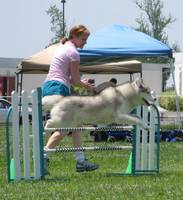Kitty litter considerations
February 28th, 2012 at 11:08 pm (Animals)
After seven years of scooping kitty litter on a daily basis, one can’t help but meditate occasionally on the environmental impact of the stuff. What kind of litter is best? And what’s the best way to dispose of the scooped-out pet waste, or the used litter?
“Litter and the Environment” (2008) discusses the environmental impact of clay, silica, and plant-based litters. Did you know that the raw clay material (sodium bentonite) is obtained through strip mines, and that “The United States Geological Society estimates that 85 percent of the 2.54 million tons of clay used in this country every year is used for absorption of pet waste, with cat litter being the dominant”? That’s about 2.15 million tons of (ultimately) used-up clay that goes, most likely, into landfills. The article concludes that plant-based litters may cause the least environmental impact, but ultimately there is no perfect solution.
Some alternatives to clay-based litter that caught my eye, and have favorable comments in discussion fora, are:

- Feline Pine: litter made from pine wood. Some people really like it; some find the pine smell annoying. You can get a rebate for one bag of Feline Pine to try it out for free.
- Yesterday’s News: litter made from recycled paper
- Swheat Scoop: litter made from wheat. I tried this for a while but found it didn’t cover odors as well as the clay-based litter.
These are inevitably more expensive than clay-based litters, but might ease your environmental conscience. For the ultimate in cost savings (at the expense of time), you can make your own paper-based litter.
Once you select a litter, there’s still the question of how to dispose of it after it’s used. I scoop waste (pee clumps and feces) from the litter into a Litter Locker, which is super handy (and keeps odors down) but not only consumes plastic, it seals the waste for eternity and guarantees it’ll never break down. But you can’t compost it (temperatures don’t get high enough to break down feces), you shouldn’t flush it (can clog pipes, and there’s a small risk of infecting marine life with toxoplasmosis, although apparently VERY small risk if your cat lives indoors and doesn’t eat mice), and from what I’ve read, most sources regretfully recommend sending it to the landfill. Probably the best solution is to put it in a paper bag or something a little more likely to ultimately decompose (versus plastic), then put it out with your trash.
I change out the unused litter very rarely, like every few months. From browsing online, I learned that some people just let the box fill up with waste and then throw out the whole thing once a week, which must make them go through a ton of litter! Why why why?
Finally, no discussion of this issue would be complete without mentioning the alternative strategy of toilet-training your cat, which uses no litter and takes another chore off your hands. However, the small toxoplasmosis risk would still be present.
I’m considering trying out Feline Pine and/or Yesterday’s News, just to see how well they work (and whether my cat will use them!). And I may try to devise an alternative to the Litter Locker that avoids the use of plastic. Hmm.

